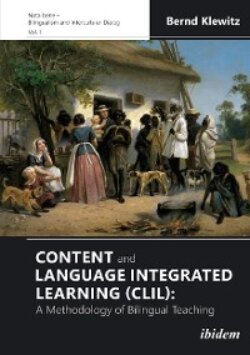Оглавление
Bernd Klewitz. Content and Language Integrated Learning (CLIL): A Methodology of Bilingual Teaching
Introduction
Chapter 1. Bilingual Children. Vignette “A Family Experiment”
1.1 Dismantling Myths and Legends of Bilingualism
1.2 The Guide for Bilingual Parents
1.3 The Graduate Medical School of Hanover
1.4 The Gap Between Knowing and Doing
1.5 The Dual System Hypothesis
1.6 The Unitary Language System Hypothesis
Chapter 2. Nativist and Cognitive Positions. Vignette “Language is the dress of thought”
2.1 The Research on Second Language Acquisition
2.2 Behaviorism and a Black Box
2.3 The Universal Grammar and Noam Chomsky
2.4 The Minimalist Position of Recursion
2.5 The Input and Output Hypotheses
2.6 Language Learning as a Social Process—The Zone of Proximal Development (ZPD)
Chapter 3. Nature versus Nurture. Vignette “The American Experience”
3.1 The Fundamental Difference Hypothesis
3.2 Linking Nature and Nurture
3.3 Anthropology Sheds a New Light
3.4 The Neuro-biological View
3.5 The Task-based Approach
Chapter 4. Learning (Foreign) Languages in Cultural Contexts—Historic and Current Developments. Vignette “The Dunera Boys”
4.1 Communicative Language Teaching and the Grammar Question
4.2 The Common European Framework for Languages
4.3 Rethinking Foreign Language Teaching
4.4 The Two Tales of CLIL
4.5 CLIL Example—Teaching “Bauhaus” Professor Ingrid Zeller; Northwestern University. The “Bauhaus School” in the German Curriculum
The History of the Bauhaus
The Bauhaus Influence Worldwide
Bauhaus in Chicago Initiative
Course Curriculum: Bauhaus in Chicago: German Influences on the Chicago Skyline
Introductory Activities
Exploring the World of Architecture
Learning about the History of Chicago
Learning about the History of the Bauhaus
Bauhaus Learning Stations
Grammar and the Bauhaus
Linguistic Focus
Communication and the Community through Excursions
Conversations with Dirk Lohan
Immersion Experience
Written Tasks: Articles about Buildings
Student Tours—Presentational Speaking Onsite
Presentational Speaking and Video Production
Collaborative Dimension
Bibliography
Historical / Informative Websites: Planet-Schule: Architektur
Bauhaus Links:
Tools:
Videos: Arte: Das Bauhaus (6 Minuten)
Zur Eröffnung des neuen Bauhaus Museums in Weimar) (2:13 Minuten)
Versuch, das Leben zu ordnen”
Arte: Das Bauhaus. Films:
Chapter 5. Dimensions and Contexts of Bilingual Teaching. Vignette “Intercultural Encounters in Student Exchanges”
5.1 Scotland
5.2 Canada and the US
5.3 Australia (& Deutsche Schule Melbourne)
5.4 Germany and Europe
5.5 Learning Principles
5.6 Principles of Quality Teaching (Luther College)
5.7 Teaching Design as an Instructional Model (McKinnon Secondary College)
5.8 Linguistic Risk Taking (Ottawa)
Chapter 6. Building Blocks of CLIL. Vignette “Windows in the Foreign Language Classroom”
6.1 Features of Multi-perspective Learning
6.2 Guiding Questions for CLIL Lesson Planning
6.3 The 4 Cs Framework
CLIL example
CLIL example
CLIL example
CLIL example
6.4 Discourse Competences—Bridging BICS and CALP
CLIL Example
6.5 The Language Triptych
6.6 The Bilingual Triangle and the Third Space
6.7 Task Design Wheel and Task-verbs
6.8 Primacy of Content
6.9 Scaffolding as a Dual Teaching Strategy
Chapter 7. Literary CLIL. Vignette “Intertextuality”
Manifest Destiny and the Louisiana Purchase
7.1 Literature as Part of the Bilingual Curriculum
7.2 Literature in the CEF
7.3 Selection Criteria
7.4 Narratives of Literary CLIL
7.5 Literary CLIL as a Theory of Practice
7.6 Study Design for Literary Analysis and Criticism
VCE Literature Study Design—Unit 1
VCE Literature Study Design—Unit 2
VCE Literature Study Design—Unit 3
VCE Literature Study Design—Unit 4
7.7 Literary Studies in Contexts, Genres and Target Countries
CLIL example short story. South Africa—Nadine Gordimer: Beethoven was One Sixteenth Black (short story: 2007) Short story as a genre
The author and the short story
Learning aims and objectives:
Colonial policies and attitudes—what to do with the natives?
Tasks:
Answers
Great Britain—Andrea Levy: Loose Change (short story: 2005) The author and the short story
1. The Caribbean Background
2. Glamour and poverty in London
3. The Streets of London (Ralph McTell)
Task—creative writing
CLIL example novel. Colson Whitehead—The Underground Railroad (2016) The author and the novel
The content:
Thomas King—Green Grass, Running Water (1993) This example is a tri-partite module of prose, history source and learning activities. The author and the novel
The Inconvenient Indian (2012) by Thomas King
Indians are … the Creation Myth
Colson Whitehead/Thomas King—Magic Realism. Magic Realism
Australia—Tim Winton: Breath (1999) The author and the novel
Discussion
Excerpt (Breath)
Task (creative writing)
The genres of music, poetry and rap will be outlined in some detail in the next section. CLIL example poetry
Lothar Balzer
CLIL example music/lyrics
The Roots of Jazz. 12 years a slave—choir song—”roll jordan roll”
First listening: Gospel Soul—“Swing low, sweet chariot”
Second listening:
The Entertainer by Scott Joplin
Australian Samples: Beds Are Burning and My Island Home. Beds are Burning by Midnight Oil
My Island Home by Christine Anu
While:
7.8 Intertextuality. Ich mag keine Gedichte—warum ich trotzdem Gedichte lese (Lothar Balzer)
Bauhaus (Lothar Balzer)
Ludwig Hirschfeld-Mack* The Dunera Boys (Episode 2; the National Sound and Film Archive Australia)
Chapter 8. CLIL Tools and Skills. Vignette “Worksheet Compass”
8.1 Scaffolding as a Tool in CLIL
8.2 Task-based Language Teaching (TBLT)
CLIL/FLT example
8.3 English Unlimited (blended content-language learning)
8.4 The Visual Turn
CLIL example
8.5 Learnscapes
Chapter 9. CLIL Modules. Vignette “Teaching Units”
9.1 Measuring Your Media (A2) Electronic devices—curse or blessing?
9.2 Refugees (A2)
9.3 Analysing Political Cartoons (B1)
9.4 Jacobites and Enlightenment (B1)
9.5 Caledonia—Creating a Podcast (B2)
9.6 War and Peace—Calvin and Hobbes (B2)
9.7 Herringbone Technique (B2+)
9.8 Absolutism (B2+)
9.9 Reciprocal Teaching (C1)
9.10 International Relations—Libya (C1)
Chapter 10. CLIL Challenges and Desiderata. Vignette “Venn Diagram”
10.1 CLIL as a Catalyst for Change
10.2 The Innovative Potential
10.3 Competence and Content—a CLIL Example. Pop culture and the media hype (Amy Macdonald)
10.4 Future Directions
Glossary of Teaching Strategies and Learning Skills. Content and Language Integrated Learning (CLIL): A Methodology of Bilingual Teaching
Literature
